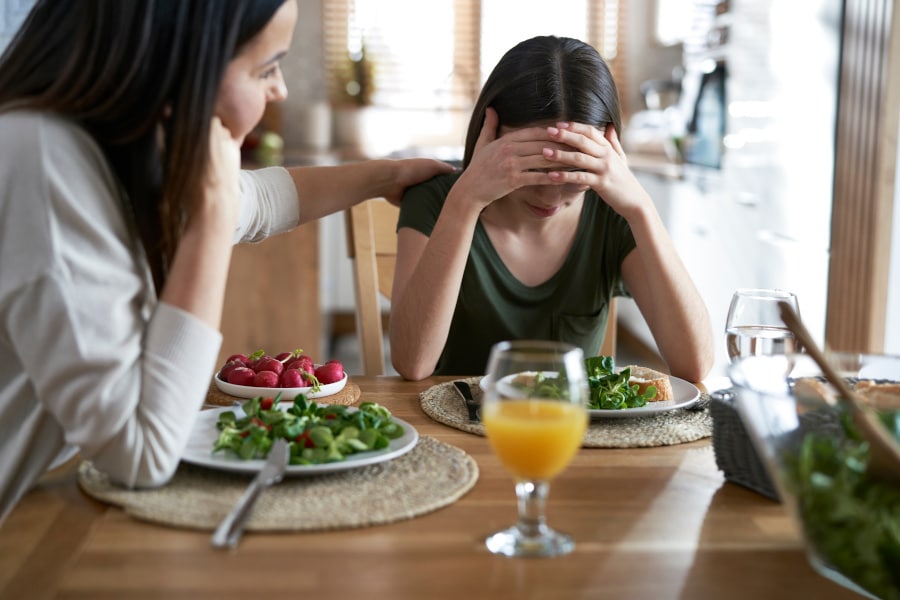Winter brings forth the image of light. Twinkling lights on the Christmas tree, families gathered around the glow of the fireplace, the north star guiding the way for the wisemen. It is the festive season, full of light, a time that for some feels like a Hallmark movie of wintry wonderlands and pink cheeks. The reality of the season for many others is the feeling that the dreary winter carries on, cold and gray. A season of seemingly ceaseless darkness. For some, the absence of light leads to a seasonal depression that can feel never-ending. For those already struggling with an eating disorder, the additional stress of this season can be oppressive. This depression, which can feel dark and eternal, really does just last a season. A better understanding of how to cope with seasonal depression will have less of a negative effect on eating disorders. Approaching the season full of knowledge will combat the darkness, and serve as a reminder that there will soon be light.
What is Seasonal Affective Disorder?
Seasonal Affective Disorder (SAD) is a type of depression that’s related to changes in seasons and begins and ends at about the same time each year. SAD occurs in places where there is less sunlight at certain times of the year. Symptoms of SAD include fatigue, depression, hopelessness, and social withdrawal. More than just the Winter Blues, SAD can be serious and in some cases can affect how a person feels, thinks and handles daily activities.
Who Gets SAD?
SAD is very common. According to the Mayo Clinic, more than three million people get SAD each year just in the United states alone, although many more may not even know they have the condition. SAD occurs more frequently in women than in men, and it is more common in those living farther north, where there are shorter daylight hours in the winter. In most cases, SAD begins in young adulthood.
SAD can sometimes run in families and is more prevalent in people who have relatives with other mental illnesses. SAD is more common in people with other disorders, including eating disorders, and SAD can exacerbate symptoms that already exist. It is especially important for a person with an eating disorder to be aware of the symptoms so if you are displaying any, you can reach out to your Selah House team as soon as possible.
What Causes SAD?
The causes of SAD are not yet fully understood. Recent research has shown that people with SAD may have reduced levels of serotonin, a chemical that helps regulate mood. The vitamin D in sunlight helps maintain normal serotonin levels. With less daylight in the winter, people with SAD may have lower vitamin D levels, which may reduce serotonin activity.
Some findings suggest that people with SAD produce too much melatonin. Melatonin is a hormone that regulates the normal sleep cycle. Overproduction of melatonin can increase sleepiness. Extreme fatigue is a common symptom of SAD.
Both serotonin and melatonin help maintain the body’s night and day cycle. In people with SAD, the changes in serotonin and melatonin levels disrupt the normal daily rhythms. As a result, they can no longer adjust to the seasonal changes that reduce daylight hours, leading to sleep, mood, and behavior changes.
The Relationship Between SAD and Eating Disorders
SAD is overrepresented in people with eating disorders and studies show symptoms of eating disorders tend to worsen in the colder months. Depression causes a mood disturbance and those that struggle with it may try various behaviors to cope. Some of these behaviors are harmful, like restricting, binging, and/or purging.
Binge eating behaviors may be used as an attempt to cope with the unregulated emotions caused by SAD. When the winter weather hits and depression sets in, feelings of worthlessness may increase, binging is used as a coping mechanism, which leads to more feelings of worthlessness, and a cycle can ensue.
Bulimia Nervosa is an eating disorder with the highest co-occurrence of major depression. The decreased daylight can be a big trigger. Bulimia and depression have a lot of the same symptoms, such as low self-worth, isolation, feeling out of control, anger/irritability, and inadequacy. These disorders also have the shared symptom of impaired social functioning.
Is There Hope?
Yes, there is absolutely hope. Being aware of Seasonal Affective Disorder and its impact on eating disorders is the first step. Knowing what symptoms to look for and identifying that you have a problem is the next step. If you do feel like you have SAD and are concerned it might cause you to relapse into some less than desirable patterns, seeking help is ultimately the best step. Understand that you are not alone, that millions of Americans struggle with SAD each year and it does not mean that you are weak or worthless. Communicate with your support team at Selah House to set up the treatment options that are best for you.
With guidance from your health and medical professionals, you may explore light therapy, sometimes called phototherapy. This form of light exposure is designed to mimic outdoor light. Researchers believe this type of light exposure causes a chemical change in the brain that lifts your mood and eases some symptoms of SAD.
Talk therapy is another form of therapy that is popular with treating SAD and eating disorders. Communicating with a trained therapist can help you deal with negative thoughts and feelings and make a plan for positive change.
Sometimes medication is prescribed during this difficult season to help you with SAD. Medication can be used in conjunction with other therapies, but must always be prescribed by a medical professional.
Light at the End of the Tunnel
Winter, like depression, can seem like endless darkness. But winter does not last forever. The light returns, and with it, a new season. There is help during this difficult season. If you feel the symptoms of Seasonal Affective Disorder might trigger patterns or behaviors you have worked to overcome, seek help. Your team of caring professionals at Selah House will help you find the light.



